Brealey, Myers. Principles of Corporate Finance. 7th edition
Подождите немного. Документ загружается.

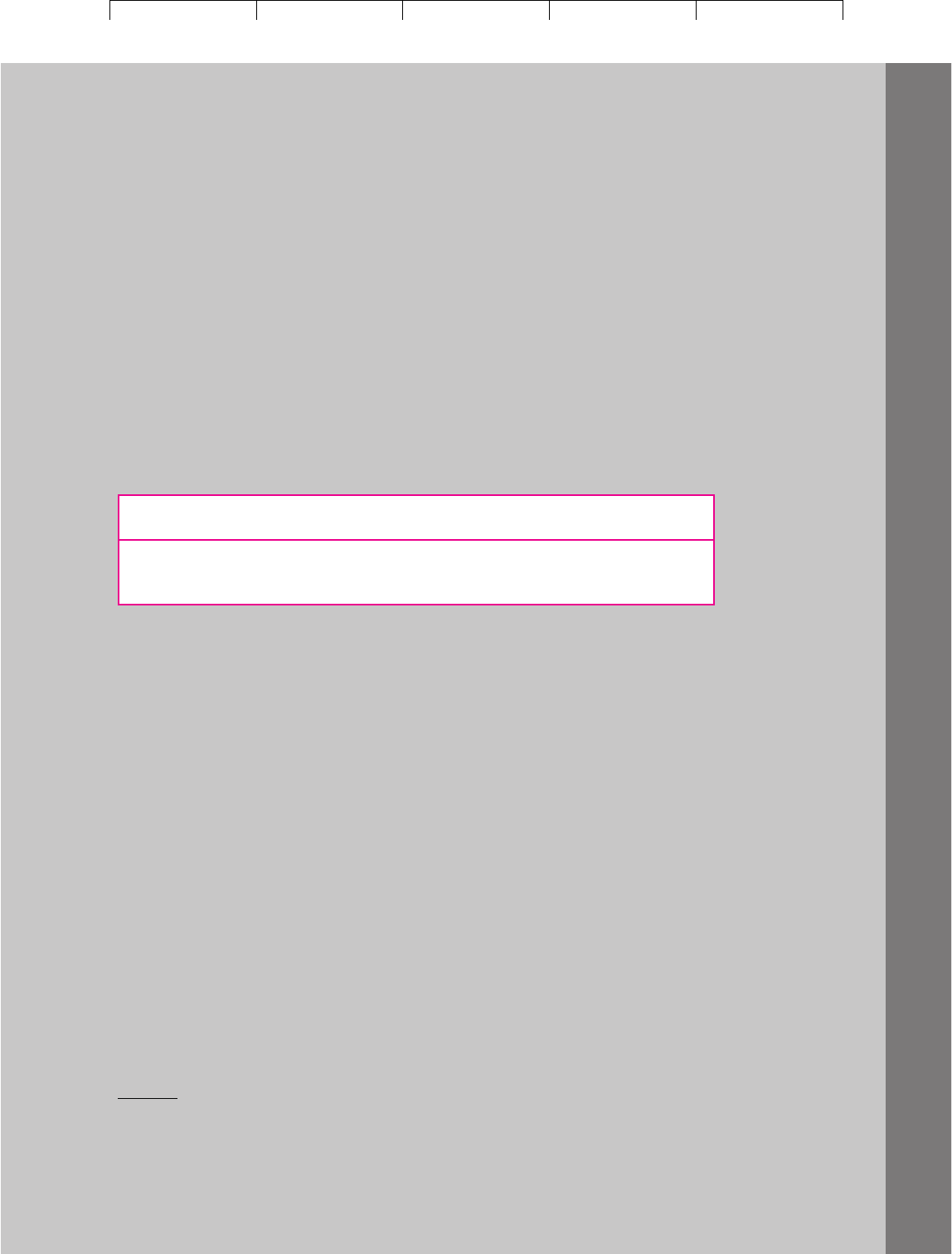
Brealey−Meyers:
Principles of Corporate
Finance, Seventh Edition
VI. Options 23. Warrants and
Convertibles
© The McGraw−Hill
Companies, 2003
CHAPTER 23 Warrants and Convertibles 663
Visit us at www.mhhe.com/bm7e
• Stock: 36 million shares, which closed at $10 per share on the day before the murder. The
company had just announced a regular quarterly dividend of $.10 per share, and the
shares were due to go ex-dividend in two weeks.
• Warrants: Warrants to buy an additional four million shares at $10 per share, expiring in
three months time on December 31, 2003. The recent volatility of the shares had been
around 50 percent per annum.
Yesterday Thorndike had flatly rejected an offer by T. Spoone Dickens to buy all
Thorndike’s assets for $1 billion cash, effective January 1, 2004. With Thorndike out of the
way, it appeared that Dickens’s offer would be accepted, much to the profit of Thorndike
Oil’s other shareholders.
26
Thorndike’s two nieces, Doris and Patsy, and his nephew John all had substantial in-
vestments in Thorndike Oil and had bitterly disagreed with Thorndike’s dismissal of Dick-
ens’s offer. Their stakes are shown in the table below.
All debt issued by Thorndike Oil would be paid off at face value if Dickens’s offer went
through.
Morse kept coming back to the problem of motive. Which niece or nephew, he wondered,
stood to gain most by eliminating Thorndike and allowing Dickens’s offer to succeed?
26
Rupert Thorndike’s shares would go to a charitable foundation formed to “advance the study of fi-
nancial engineering and its crucial role in world peace and progress.” The managers of the foundation’s
endowment were not expected to oppose the takeover.
Debt Stock Warrants
(Face Value) (Number of Shares, in Millions) (Number, in Millions)
Doris $6 million 1.0 0
John 0 .5 2
Patsy 0 1.5 1
Questions
Help Morse by answering the following questions:
1. Value the company’s debt, stock, and warrants both before and after Mr. Thorndike’s
death.
2. Which of Thorndike’s relatives stood to gain most from his death?
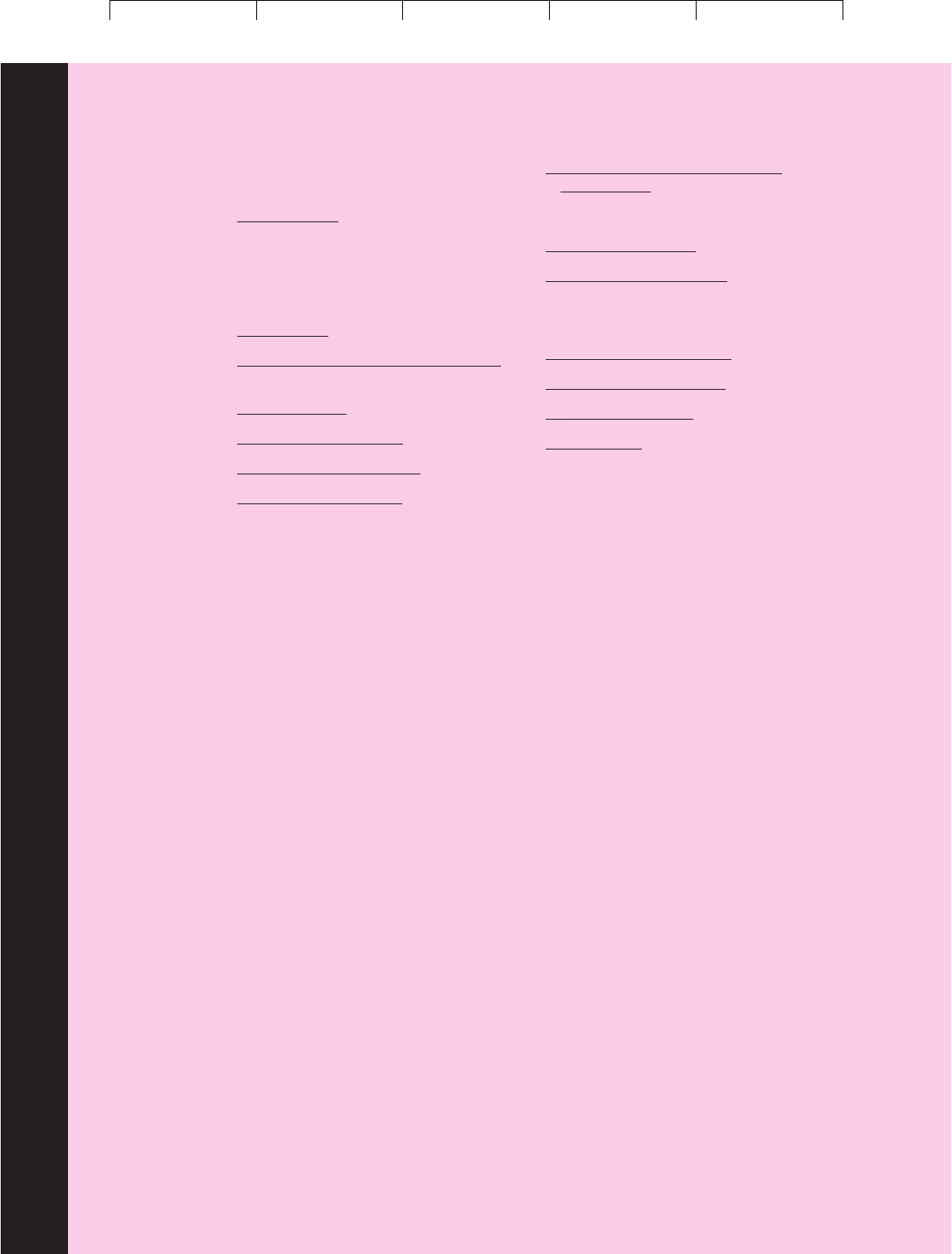
Brealey−Meyers:
Principles of Corporate
Finance, Seventh Edition
VI. Options 23. Warrants and
Convertibles
© The McGraw−Hill
Companies, 2003
RELATED WEBSITES
The Chicago Board site contains explanations of
options markets and lots of data:
www
.cboe.com
There are a number of good options sites, many
of which provide data and calculators for
Black–Scholes values and implied standard
deviations:
www
.cfo.com
www
.fintools.net/options/optcalc.html
(very good calculators)
www
.numa.com
www.optionscentral.com
www.pcquote.com/options
www.pmpublishing.com (includes historical
implied volatilities)
www.schaffersresearch.com/stock/
calculator
.asp
Two sites devoted to real options are:
www
.real-options.com
www
.puc-rio.br/marco.ind
Examples of journals specializing in options
and other derivatives include:
www
.appliederivatives.com
www
.erivativesreview.com
www.futuresmag.com
www.risk.com
PART SIX
RELATED
WEBSITES

Brealey−Meyers:
Principles of Corporate
Finance, Seventh Edition
VII. Debt Financing 24. Valuing Debt
© The McGraw−Hill
Companies, 2003
CHAPTER TWENTY-FOUR
666
VALUING DEBT

Brealey−Meyers:
Principles of Corporate
Finance, Seventh Edition
VII. Debt Financing 24. Valuing Debt
© The McGraw−Hill
Companies, 2003
HOW DO YOU estimate the present value of a company’s bonds? The answer is simple: You take the cash
flows and discount them at the opportunity cost of capital. Therefore, if a bond produces cash flows of
C dollars per year for N years and is then repaid at its face value ($1,000), the present value is
where are the appropriate discount rates for the cash flows to be received by the bond
owners in periods
That is correct as far as it goes but it does not tell us anything about what determines the discount
rates. For example,
• In 1945 U.S. Treasury bills offered a return of .4 percent: At their 1981 peak they offered a re-
turn of over 17 percent. Why does the same security offer radically different yields at different
times?
• In mid-2001 the U.S. Treasury could borrow for one year at an interest rate of 3.4 percent, but it
had to pay nearly 6 percent for a 30-year loan. Why do bonds maturing at different dates offer dif-
ferent rates of interest? In other words, why is there a term structure of interest rates?
• In mid-2001 the United States government could issue long-term bonds at a rate of nearly
6 percent. But even the most blue-chip corporate issuers had to pay at least 50 basis points
(.5 percent) more on their long-term borrowing. What explains the premium that firms have
to pay?
These questions lead to deep issues that will keep economists simmering for years. But we can give
general answers and at the same time present some fundamental ideas.
Why should the financial manager care about these ideas? Who needs to know how bonds are
priced as long as the bond market is active and efficient? Efficient markets protect the ignorant
trader. If it is necessary to know whether the price is right for a proposed bond issue, you can check
the prices of similar bonds. There is no need to worry about the historical behavior of interest rates,
about the term structure, or about the other issues discussed in this chapter.
We do not believe that ignorance is desirable even when it is harmless. At least you ought to be
able to read the bond tables in The Wall Street Journal and talk to investment bankers about the
prices of recently issued bonds. More important, you will encounter many problems of bond pricing
where there are no similar instruments already traded. How do you evaluate a private placement with
a custom-tailored repayment schedule? How about financial leases? In Chapter 26 we will see that
they are essentially debt contracts, but often extremely complicated ones, for which traded bonds
are not close substitutes. Many companies, notably banks and insurance firms, are exposed to the
risk of interest rate fluctuations. To control their exposure, these companies need to understand how
interest rates change.
1
You will find that the terms, concepts, and facts presented in this chapter are
essential to the analysis of these and other practical problems.
We start the chapter with our first question: Why does the general level of interest rates change
over time? Next we turn to the relationship between short- and long-term interest rates. We consider
three issues:
• Each period’s cash flow on a bond potentially needs to be discounted at a different interest rate,
but bond investors often calculate the yield to maturity as a summary measure of the interest rate
on the bond. We first explain how these measures are related.
continued
1, 2, . . . , N.
r
1
, r
2
, . . . , r
N
PV ⫽
C
1 ⫹ r
1
⫹
C
11 ⫹ r
2
2
2
⫹
…
⫹
C
11 ⫹ r
N
2
N
⫹
$1,000
11 ⫹ r
N
2
N
667
1
We discuss in Chapter 27 how firms protect themselves against interest rate risk.

Brealey−Meyers:
Principles of Corporate
Finance, Seventh Edition
VII. Debt Financing 24. Valuing Debt
© The McGraw−Hill
Companies, 2003
Indexed Bonds and the Real Rate of Interest
In Chapter 3 we drew the distinction between the real and nominal rate of interest.
Most bonds promise a fixed nominal rate of interest. The real interest rate that you
receive depends on the inflation rate. For example, if a one-year bond promises you
a return of 10 percent and the expected inflation rate is 4 percent, the expected real
return on your bond is , or 5.8 percent. Since future inflation
rates are uncertain, the real return on a bond is also uncertain. For example, if in-
flation turns out to be higher than the expected 4 percent, the real return will be
lower than 5.8 percent.
You can nail down a real return; you do so by buying an indexed bond whose
payments are linked to inflation. Indexed bonds have been around in many coun-
tries for decades, but they were almost unknown in the United States until 1997
when the U.S. Treasury began to issue inflation-indexed bonds known as TIPs
(Treasury Inflation-Protected Securities).
2
The real cash flows on TIPs are fixed, but the nominal cash flows (interest and
principal) are increased as the Consumer Price Index increases. For example, sup-
pose that the U.S. Treasury issues 3 percent 20-year TIPs at a price of 100. If during
the first year the Consumer Price Index rises by (say) 10 percent, then the coupon
payment on the bond would be increased by 10 percent to percent.
And the final payment of principal would also be increased in the same proportion
to percent. Thus, an investor who buys the bond at the issue
price and holds it to maturity can be assured of a real yield of 3 percent.
As we write this in the summer of 2001, long-term TIPs offer a yield of 3.46 per-
cent. This yield is a real yield: It measures how much extra goods your investment
would allow you to buy. The 3.46 percent yield on TIPs was about 2.3 percent less
than on nominal Treasury bonds. If the annual inflation rate proves to be higher
than 2.3 percent, you will earn a higher return by holding long-term TIPs; if the in-
flation rate is lower than 2.3 percent, the reverse will be true.
What determines the real interest rate that investors demand? The classical econ-
omist’s answer to this question is summed up in the title of Irving Fisher’s great
book: The Theory of Interest: As Determined by Impatience to Spend Income and Opportu-
nity to Invest It.
3
The real interest rate, according to Fisher, is the price which equates
11.1 ⫻ 1002⫽ 110
11.1 ⫻ 32⫽ 3.3
1.10/1.04 ⫺ 1 ⫽ .058
668 PART VII
Debt Financing
• Second, we show why a change in interest rates has a greater impact on the price of long-term
loans than on short-term loans.
• Finally, we look at some theories that explain why short- and long-term interest rates differ.
To close the chapter we shift the focus to corporate bonds and examine the risk of default and its ef-
fect on bond prices.
24.1 REAL AND NOMINAL RATES OF INTEREST
2
In 1988 Franklin Savings Association had issued a 20-year bond whose interest (but not principal) was
tied to the rate of inflation. Since then a trickle of companies has also issued indexed bonds.
3
August M. Kelley, New York, 1965; originally published in 1930.
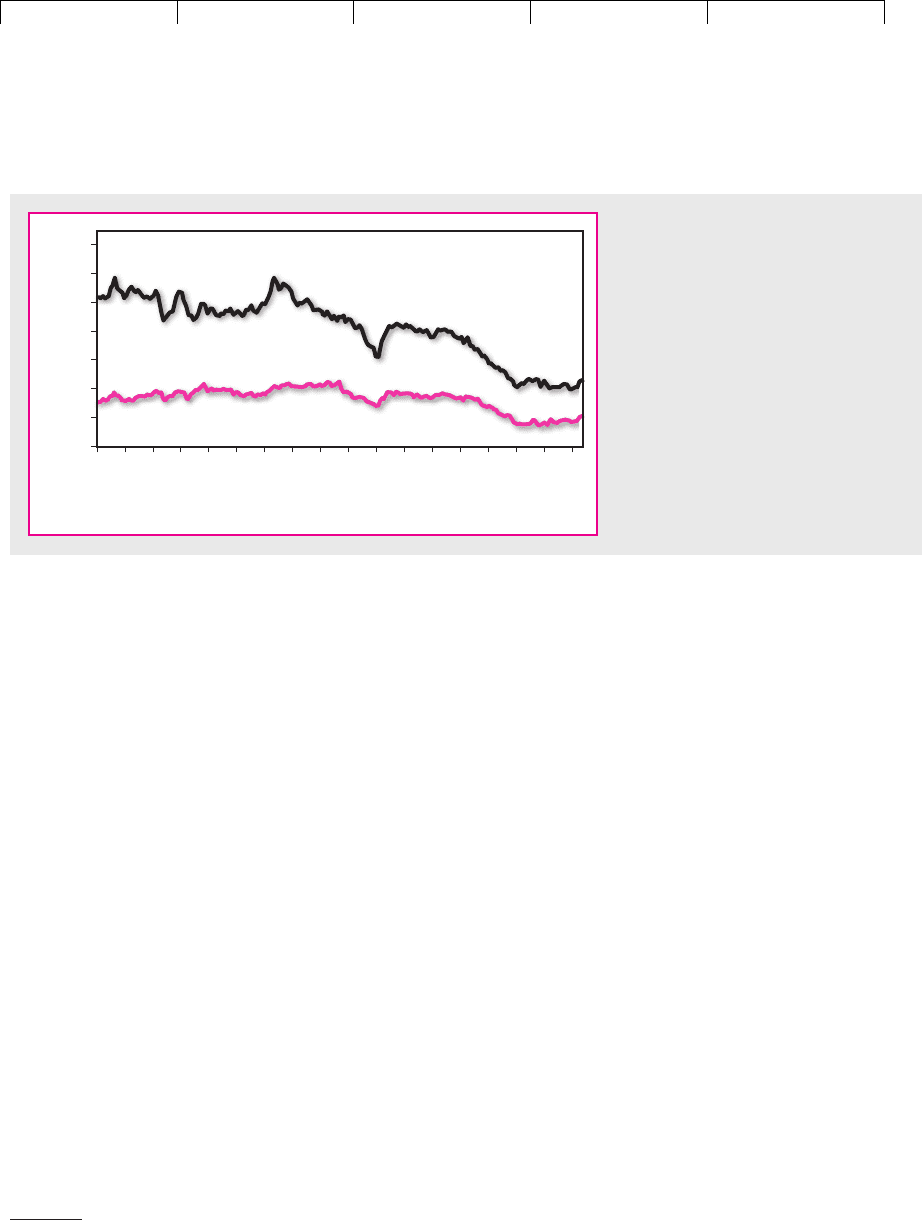
Brealey−Meyers:
Principles of Corporate
Finance, Seventh Edition
VII. Debt Financing 24. Valuing Debt
© The McGraw−Hill
Companies, 2003
the supply and demand for capital. The supply depends on people’s willingness to
save.
4
The demand depends on the opportunities for productive investment.
For example, suppose that investment opportunities generally improve. Firms
have more good projects, so they are willing to invest more than previously at any
interest rate. Therefore, the rate has to rise to induce individuals to save the addi-
tional amount that firms want to invest.
5
Conversely, if investment opportunities
deteriorate, there will be a fall in the real interest rate.
Fisher’s theory emphasizes that the required real rate of interest depends on real
phenomena. A high aggregate willingness to save may be associated with high ag-
gregate wealth (because wealthy people usually save more), an uneven distribu-
tion of wealth (an even distribution would mean fewer rich people, who do most
of the saving), and a high proportion of middle-aged people (the young don’t need
to save and the old don’t want to—“You can’t take it with you”). Correspondingly,
a high propensity to invest may be associated with a high level of industrial activ-
ity or major technological advances.
Real interest rates do change but they do so gradually. We can see this by look-
ing at the UK, where the government has issued indexed bonds since 1982. The col-
ored line in Figure 24.1 shows that the (real) yield on these bonds has fluctuated
within a relatively narrow range, while the yield on nominal government bonds
has declined dramatically.
Inflation and Nominal Interest Rates
Now let us see what Irving Fisher had to say about inflation and interest rates. Sup-
pose that consumers are equally happy with 100 apples today or 105 apples in a
year’s time. In this case the real or “apple” interest rate is 5 percent. Suppose also
CHAPTER 24
Valuing Debt 669
4
Some of this saving is done indirectly. For example, if you hold 100 shares of GM stock, and GM re-
tains earnings of $1 per share, GM is saving $100 on your behalf.
5
We assume that investors save more as interest rates rise. It doesn’t have to be that way; here is an ex-
ample of how a higher interest rate could mean less saving: Suppose that 20 years hence you will need
$50,000 at current prices for your children’s college expenses. How much will you have to set aside to-
day to cover this obligation? The answer is the present value of a real expenditure of $50,000 after 20
years, or . The higher the real interest rate, the lower the present value
and the less you have to set aside.
50,000/1 1 ⫹ real interest rate2
20
Dec. 83
Dec. 84
Dec. 85
Dec. 86
Dec. 87
Dec. 88
Dec. 89
Dec. 90
Dec. 91
Dec. 92
Dec. 93
Dec. 94
Dec. 95
Dec. 96
Dec. 97
Dec. 98
Dec. 99
Dec. 00
0
2
4
6
8
10
12
14
Percent
Real yield on UK indexed bonds
Yield on UK nominal bonds
FIGURE 24.1
The burgundy line shows the real yield
on long-term indexed bonds issued by
the UK government. The blue line
shows the yield on UK government
long-term nominal bonds. Notice that
the real yield has been much more
stable than the nominal yield.

Brealey−Meyers:
Principles of Corporate
Finance, Seventh Edition
VII. Debt Financing 24. Valuing Debt
© The McGraw−Hill
Companies, 2003
that I know the price of apples will increase over the year by 10 percent. Then I will
part with $100 today if I am repaid $115 at the end of the year. That $115 is needed
to buy me 5 percent more apples than I can get for my $100 today. In other words,
the nominal, or “money,” rate of interest must equal the required real, or “apple,”
rate plus the prospective rate of inflation.
6
A change of 1 percent in the expected in-
flation rate produces a change of 1 percent in the nominal interest rate. That is
Fisher’s theory: A change in the expected inflation rate will cause the same change
in the nominal interest rate; it has no effect on the required real interest rate.
7
Nominal interest rates cannot be negative; if they were, everyone would prefer
to hold cash, which pays zero interest.
8
But what about real rates? For example, is
it possible for the money rate of interest to be 5 percent and the expected rate of in-
flation to be 10 percent, thus giving a negative real interest rate? If this happens,
you may be able to make money in the following way: You borrow $100 at an in-
terest rate of 5 percent and you use the money to buy apples. You store the apples
and sell them at the end of the year for $110, which leaves you enough to pay off
your loan plus $5 for yourself.
Since easy ways to make money are rare, we can conclude that if it doesn’t cost
anything to store goods, the money rate of interest can’t be less than the expected
rise in prices. But many goods are even more expensive to store than apples, and
others can’t be stored at all (you can’t store haircuts, for example). For these goods,
the money interest rate can be less than the expected price rise.
How Well Does Fisher’s Theory Explain Interest Rates?
Not all economists would agree with Fisher that the real rate of interest is unaf-
fected by the inflation rate. For example, if changes in prices are associated with
changes in the level of industrial activity, then in inflationary conditions I might
want more or less than 105 apples in a year’s time to compensate me for the loss of
100 today.
We wish we could show you the past behavior of interest rates and expected in-
flation. Instead we have done the next best thing and plotted in Figure 24.2 the re-
turn on U.S. Treasury bills against actual inflation. Notice that between 1926 and
1981 the return on Treasury bills was below the inflation rate about as often as it
670 PART VII
Debt Financing
6
We oversimplify. If apples cost $1.00 apiece today and $1.10 next year, you need
next year to buy 105 apples. The money rate of interest is 15.5 percent, not 15. Remember, the exact for-
mula relating real and money rates is
where i is the expected inflation rate. Thus
In our example, the money rate should be
When we said the money rate should be 15 percent, we ignored the cross-product term i . This is
a common rule of thumb because the cross-product term is usually small. But there are countries where
i is large (sometimes 100 percent or more). In such cases it pays to use the full formula.
7
The apple example was taken from R. Roll, “Interest Rates on Monetary Assets and Commodity Price
Index Changes,” Journal of Finance 27 (May 1972), pp. 251–278.
8
There seems to be an exception to almost every statement. In late 1998 concern about the solvency of
some Japanese banks led to a large volume of yen deposits with Western banks. Some of these banks
charged their customers interest on these deposits; the nominal interest rate was negative.
1r
real
2
r
money
⫽ .05 ⫹ .10 ⫹ .101.052⫽ .155
r
money
⫽ r
real
⫹ i ⫹ i1r
real
2
1 ⫹ r
money
⫽ 11 ⫹ r
real
2 11 ⫹ i2
1.10 ⫻ 105 ⫽ $115.50
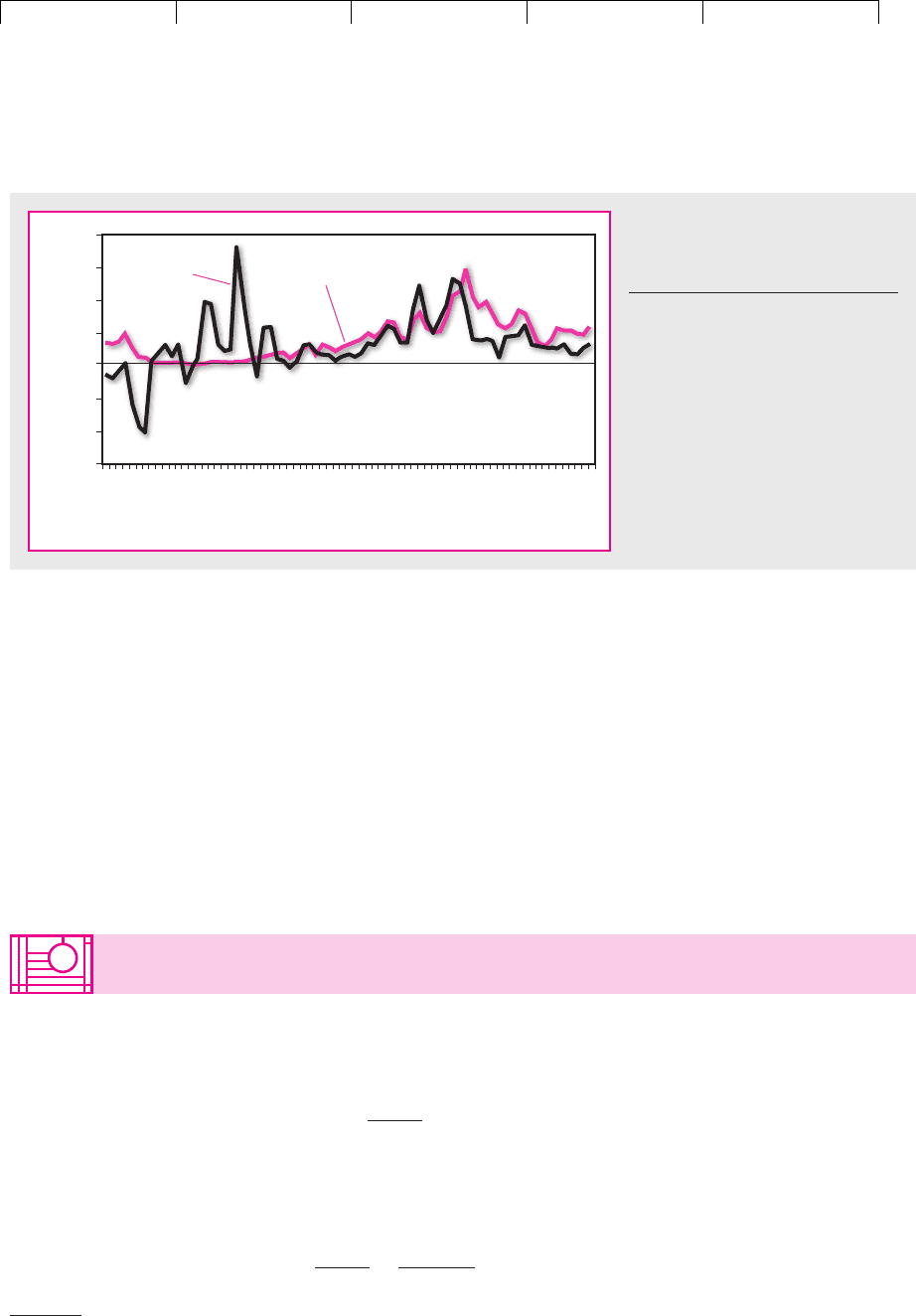
Brealey−Meyers:
Principles of Corporate
Finance, Seventh Edition
VII. Debt Financing 24. Valuing Debt
© The McGraw−Hill
Companies, 2003
was above. The average real interest rate during this period was a mere 0.1 percent.
Since 1981 the return on bills has been significantly higher than the rate of infla-
tion, so that investors have earned a positive real return on their savings.
Fisher’s theory states that changes in anticipated inflation produce correspon-
ding changes in the rate of interest. But Figure 24.2 offers little evidence of this in
the 1930s and 1940s. During this period, the return on Treasury bills scarcely
changed even though the inflation rate fluctuated sharply. Either these changes in
inflation were unanticipated or Fisher’s theory was wrong. Since the early 1950s,
there appears to have been a closer relationship between interest rates and infla-
tion in the United States.
9
Thus, for today’s financial managers Fisher’s theory pro-
vides a useful rule of thumb. If the expected inflation rate changes, it is a good bet
that there will be a corresponding change in the interest rate.
CHAPTER 24
Valuing Debt 671
1926
1931
1936
1941
1946
1951
1956
1961
1966
1971
1976
1981
1986
1991
1996
-15
-10
-5
0
Year
5
10
15
20
Percent
Inflation
Treasury bill return
FIGURE 24.2
The return on U.S. Treasury bills and
the rate of inflation, 1926–2000.
Source: Ibbotson Associates, Inc.,
Chicago, 2001.
9
This probably reflects government policy, which before 1951 stabilized nominal interest rates. The 1951
“accord” between the Treasury and the Federal Reserve System permitted more flexible nominal inter-
est rates after 1951.
24.2 TERM STRUCTURE AND YIELDS TO MATURITY
We turn now to the relationship between short- and long-term rates of interest.
Suppose that we have a simple loan that pays $1 at time 1. The present value of this
loan is
Thus we discount the cash flow at , the rate appropriate for a one-period loan.
This rate, which is fixed today, is often called today’s one-period spot rate.
If we have a loan that pays $1 at both time 1 and time 2, present value is
PV ⫽
1
1 ⫹ r
1
⫹
1
11 ⫹ r
2
2
2
r
1
PV ⫽
1
1 ⫹ r
1

Brealey−Meyers:
Principles of Corporate
Finance, Seventh Edition
VII. Debt Financing 24. Valuing Debt
© The McGraw−Hill
Companies, 2003
Thus the first period’s cash flow is discounted at today’s one-period spot rate and
the second period’s flow is discounted at today’s two-period spot rate. The series
of spot rates , etc., is one way of expressing the term structure of interest rates.
Yield to Maturity
Rather than discounting each of the payments at a different rate of interest, we could
find a single rate of discount that would produce the same present value. Such a rate
is known as the yield to maturity, though it is in fact no more than our old acquain-
tance, the internal rate of return (IRR), masquerading under another name. If we call
the yield to maturity y, we can write the present value of the two-year loan as
All you need to calculate y is the price of a bond, its annual payment, and its ma-
turity. You can then rapidly work out the yield with the aid of a preprogrammed
calculator.
The yield to maturity is unambiguous and easy to calculate. It is also the stock-
in-trade of any bond dealer. By now, however, you should have learned to treat any
internal rate of return with suspicion.
10
The more closely we examine the yield to
maturity, the less informative it is seen to be. Here is an example.
Example. It is 2003. You are contemplating an investment in U.S. Treasury bonds
and come across the following quotations for two bonds:
11
PV ⫽
1
1 ⫹ y
⫹
1
11 ⫹ y2
2
r
1
, r
2
672 PART VII Debt Financing
10
See Section 5.3.
11
The quoted bond price is known as the flat (or clean) price. The price that the bond buyer pays (some-
times called the dirty price) is equal to the flat price plus the interest that the seller has already earned on
the bond since the last interest payment date. You need to use the flat price to calculate yields to maturity.
Yield to Maturity
Bond Price (IRR)
5s of ‘08 85.21% 8.78%
10s of ‘08 105.43 8.62
The phrase “5s of ‘08” refers to a bond maturing in 2008, paying annual interest of
5 percent of the bond’s face value. The interest payment is called the coupon payment.
In continental Europe coupons are usually paid annually; in the United States they
are usually paid every six months, so the 5s of ‘08 would pay 2.5 percent of face value
every six months. To simplify the arithmetic, we will pretend throughout this chap-
ter that all coupon payments are annual. When the bonds mature in 2008, bond-
holders receive the bond’s face value in addition to the final interest payment.
The price of each bond is quoted as a percent of face value. Therefore, if face
value is $1,000, you would have to pay $852.11 to buy the bond and your yield
would be 8.78 percent. Letting 2003 be , 2004 be , etc., we have the fol-
lowing discounted-cash-flow calculation:
t ⫽ 1t ⫽ 0
Cash Flows
Bond C
0
C
1
C
2
C
3
C
4
C
5
Yield
5s of ‘08 ⫺852.11 ⫹50 ⫹50 ⫹50 ⫹50 ⫹1,050 8.78%
10s of ‘08 ⫺1,054.29 ⫹100 ⫹100 ⫹100 ⫹100 ⫹1,100 8.62
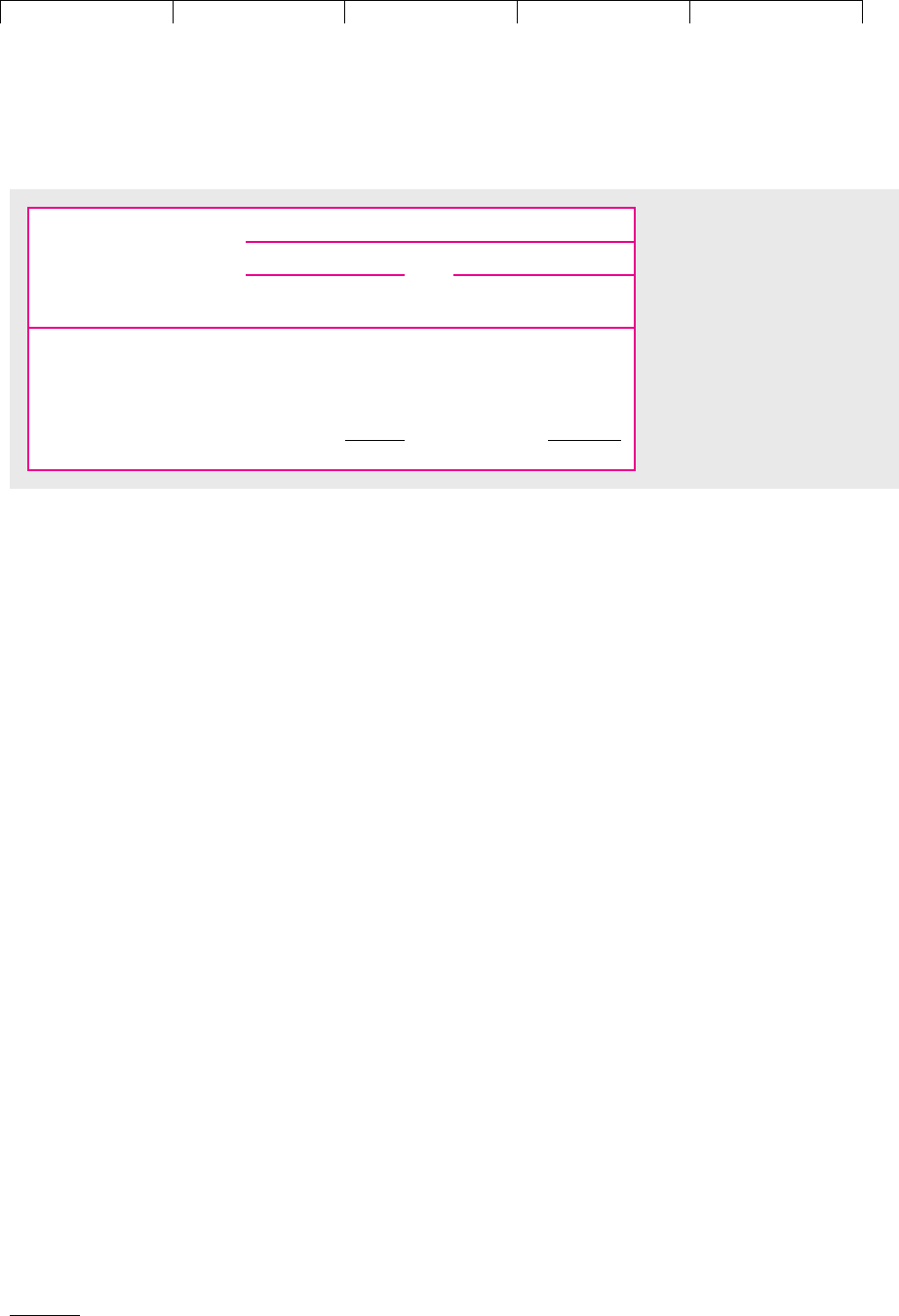
Brealey−Meyers:
Principles of Corporate
Finance, Seventh Edition
VII. Debt Financing 24. Valuing Debt
© The McGraw−Hill
Companies, 2003
Although the two bonds mature at the same date, they presumably were issued at
different times—the 5s when interest rates were low and the 10s when interest rates
were high.
Are the 5s of ‘08 a better buy? Is the market making a mistake by pricing these
two issues at different yields? The only way you will know for sure is to calculate
the bonds’ present values by using spot rates of interest: for 2004, for 2005, etc.
This is done in Table 24.1.
The important assumption in Table 24.1 is that long-term interest rates are
higher than short-term interest rates. We have assumed that the one-year interest
rate is , the two-year rate is , and so on. When each year’s cash flow
is discounted at the rate appropriate to that year, we see that each bond’s present
value is exactly equal to the quoted price. Thus each bond is fairly priced.
Why do the 5s have a higher yield? Because for each dollar that you invest in the
5s you receive relatively little cash inflow in the first four years and a relatively
high cash inflow in the final year. Therefore, although the two bonds have identi-
cal maturity dates, the 5s provide a greater proportion of their cash flows in 2008.
In this sense the 5s are a longer-term investment than the 10s. Their higher yield to
maturity just reflects the fact that long-term interest rates are higher than short-
term rates.
Notice why the yield to maturity can be misleading. When the yield is calculated,
the same rate is used to discount all payments on the bond. But in our example bond-
holders actually demanded different rates of return ( , etc.) for cash flows that oc-
curred at different times. Since the cash flows on the two bonds were not identical,
the bonds had different yields to maturity. Therefore, the yield to maturity on the 5s
of ‘08 offered only a rough guide to the appropriate yield on the 10s of ‘08.
12
Measuring the Term Structure
Financial managers who just want a quick, summary measure of interest rates look
in the financial press at the yields to maturity on government bonds. Thus managers
will make broad generalizations such as “If we borrow money today, we will have
to pay an interest rate of 8 percent.” But if you wish to understand why different
r
1
, r
2
r
2
⫽ .06r
1
⫽ .05
r
2
r
1
CHAPTER 24 Valuing Debt 673
Present Value Calculations
5s of ‘08 10s of ‘08
Interest
Period Rate C
t
PV at r
t
C
t
PV at r
t
t ⫽ 1 r
1
⫽ .05 $ 50 $ 47.62 $ 100 $ 95.24
t ⫽ 2 r
2
⫽ .06 50 44.50 100 89.00
t ⫽ 3 r
3
⫽ .07 50 40.81 100 81.63
t ⫽ 4 r
4
⫽ .08 50 36.75 100 73.50
t ⫽ 5 r
5
⫽ .09 1,050 682.43 1,100 714.92
Totals $852.11 $1,054.29
TABLE 24.1
Calculating present value of two
bonds when long-term interest
rates are higher than short-term
rates.
12
For a good analysis of the relationship between the yield to maturity and spot interest rates, see S. M.
Schaefer, “The Problem with Redemption Yields,” Financial Analysts Journal 33 (July–August 1977),
pp. 59–67.
